GEANT4 Simulation for Radioactive Particle Tracking (RPT) Technique
Abstract
:1. Introduction
- Calibration process (counts and corresponding tracer positions are known);
- Actual tracking process (counts are known while instantaneous positions of tracer are unknown);
- Reconstruction process (reconstruction algorithm is used to identify instantaneous positions of tracer).
2. The GEANT4 Model
3. Results and Discussion
3.1. The Response of a Single NaI(TI) Detector
3.2. Optimization of Optimal Primary Particles
3.3. Calibration Curves
3.4. The Response of Multiple Detectors as Function of the Tracer Position
3.5. Parity Plot (Simulation Versus Experimental)
4. Remarks
Author Contributions
Funding
Institutional Review Board Statement
Informed Consent Statement
Data Availability Statement
Acknowledgments
Conflicts of Interest
Abbreviations
| Symbols | Description | |
| : | Number of photopeak photon counts recorded by a detector. | |
| : | Time interval during which is recorded. | |
| : | Number of γ-ray photons emitted per disintegration. | |
| : | Strength of the radioactive source. | |
| : | The probability that a γ-ray will emerge from the reactor without scattering and will interact with the detector. | |
| : | The absolute detection efficiency. | |
| : | The dead time of the counting system per accepted pulse. | |
| : | The solid angle subtended by the detector. | |
| : | Separation distance between the source and the point on the surface of the detector. | |
| : | The radius vector from the source to the detector. | |
| : | Probability that gamma-rays traveling within solid angle Ω will not interact with the medium inside the reactor and the wall of reactor. | |
| : | Probability that gamma-rays traveling distance d will interact in the crystal material. | |
| : | The mass attenuation coefficient of the reactor inventory (for the energy of the γ-ray photon). | |
| : | The penetration depth through the medium inside the reactor. | |
| : | The mass attenuation coefficient of the reactor wall (for the energy of the γ-ray photon). | |
| : | The penetration depth through the medium inside the reactor wall. | |
| : | The mass attenuation coefficient of the detector crystal material (for the energy of the γ-ray photon). | |
| : | The penetration depth through the medium inside the thickness of crystal inside the detector | |
| : | Infinitesimal surface area element of the detector. |
References
- Al Mesfer, M.K.; Sultan, A.J.; Al-Dahhan, M.H. Study the effect of dense internals on the liquid velocity field and turbulent parameters in bubble column for Fischer–Tropsch (FT) synthesis by using Radioactive Particle Tracking (RPT) technique. Chem. Eng. Sci. 2017, 161, 228–248. [Google Scholar] [CrossRef]
- Al-Dahhan, M.H. Radioisotopes applications in industry: An overview. At. Peace Int. J. 2009, 2, 324–337. [Google Scholar] [CrossRef]
- Dudukovic, M.P. Opaque multiphase flows: Experiments and modeling. Exp. Therm. Fluid Sci. 2002, 26, 747–761. [Google Scholar] [CrossRef]
- Ali, N.; Al-Juwaya, T.; Al-Dahhan, M. An advanced evaluation of spouted beds scale-up for coating TRISO nuclear fuel particles using Radioactive Particle Tracking (RPT). Exp. Therm. Fluid Sci. 2017, 80, 90–104. [Google Scholar] [CrossRef] [Green Version]
- Al-Juwaya, T.; Ali, N.; Al-Dahhan, M. Investigation of hydrodynamics of binary solids mixture spouted beds using radioactive particle tracking (RPT) technique. Chem. Eng. Res. Des. 2019, 148, 21–44. [Google Scholar] [CrossRef]
- Bhusarapu, S.; Al-Dahhan, M.H.; Duduković, M.P. Solids flow mapping in a gas–solid riser: Mean holdup and velocity fields. Powder Technol. 2006, 163, 98–123. [Google Scholar] [CrossRef]
- Godfroy, L.; Chaouki, J.; Larachi, F. Position and velocity of a large particle in a gas/solid riser using the radioactive particle tracking technique. Can. J. Chem. Eng. 1999, 77, 253–261. [Google Scholar] [CrossRef]
- Efhaima, A.; Al-Dahhan, M.H. Bed diameter effect on the hydrodynamics of gas-solid fluidized beds via radioactive particle tracking (RPT) technique. The Can. J. Chem. Eng. 2017, 95, 744–756. [Google Scholar] [CrossRef]
- Cassanello, M.; Larachi, F.; Marie, M.-N.; Guy, C.; Chaouki, J. Experimental Characterization of the Solid Phase Chaotic Dynamics in Three-Phase Fluidization. Ind. Eng. Chem. Res. 1995, 34, 2971–2980. [Google Scholar] [CrossRef]
- Lin, J.S.; Chen, M.M.; Chao, B.T. A novel radioactive particle tracking facility for measurement of solids motion in gas fluidized beds. AIChE J. 1985, 31, 465–473. [Google Scholar] [CrossRef]
- Roy, S.; Larachi, F.; Al-Dahhan, M.H.; Duduković, M.P. Optimal design of radioactive particle tracking experiments for flow mapping in opaque multiphase reactors. Appl. Radiat. Isot. 2002, 56, 485–503. [Google Scholar] [CrossRef]
- Al-Juwaya, T.; Ali, N.; Al-Dahhan, M. Investigation of cross-sectional gas-solid distributions in spouted beds using advanced non-invasive gamma-ray computed tomography (CT). Exp. Therm. Fluid Sci. 2017, 86, 37–53. [Google Scholar] [CrossRef] [Green Version]
- Cassanello, M.; Larachi, F.; Kemoun, A.; Al-Dahhan, M.H.; Dudukovic, M.P. Inferring liquid chaotic dynamics in bubble columns using CARPT. Chem. Eng. Sci. 2001, 56, 6125–6134. [Google Scholar] [CrossRef]
- Chen, J.; Kemoun, A.; Al-Dahhan, M.H.; Duduković, M.P.; Lee, D.J.; Fan, L.-S. Comparative hydrodynamics study in a bubble column using computer-automated radioactive particle tracking (CARPT)/computed tomography (CT) and particle image velocimetry (PIV). Chem. Eng. Sci. 1999, 54, 2199–2207. [Google Scholar] [CrossRef]
- Rammohan, A.R.; Kemoun, A.; Al-Dahhan, M.H.; Dudukovic, M.P. A Lagrangian description of flows in stirred tanks via computer-automated radioactive particle tracking (CARPT). Chem. Eng. Sci. 2001, 56, 2629–2639. [Google Scholar] [CrossRef]
- Chen, R.C.; Reese, J.; Fan, L.S. Flow structure in a three-dimensional bubble column and three-phase fluidized bed. AIChE J. 1994, 40, 1093–1104. [Google Scholar] [CrossRef]
- Larachi, F.; Chaouki, J.; Kennedy, G.; Dudukovic, M.P. Chapter 11—Radioactive particle tracking in multiphase reactors: Principles and applications. In Non-Invasive Monitoring of Multiphase Flows; Duduković, J.C.L.P., Ed.; Elsevier Science B.V.: Amsterdam, The Netherlands, 1997; pp. 335–406. [Google Scholar]
- Godfroy, L.; Larachi, F.; Kennedy, G.; Grandjean, B.; Chaouki, J. On-line flow visualization in multiphase reactors using neural networks. Appl. Radiat. Isot. 1997, 48, 225–235. [Google Scholar] [CrossRef]
- Bhusarapu, S.; Al-Dahhan, M.; Dudukovic, M.P. Quantification of solids flow in a gas–solid riser: Single radioactive particle tracking. Chem. Eng. Sci. 2004, 59, 5381–5386. [Google Scholar] [CrossRef]
- Larachi, F.; Kennedy, G.; Chaouki, J. A γ-ray detection system for 3-D particle tracking in multiphase reactors. Nucl. Instrum. Methods Phys. Res. Sect. A Accel. Spectrometers Detect. Assoc. Equip. 1994, 338, 568–576. [Google Scholar] [CrossRef]
- Mosorov, V.; Abdullah, J. MCNP5 code in radioactive particle tracking. Appl. Radiat. Isot. 2011, 69, 1287–1293. [Google Scholar] [CrossRef]
- Tsoulfanidis, N. Measurement and Detection of Radiation; CRC Press: Boca Raton, FL, USA, 2010. [Google Scholar]
- Beam, G.B.; Wielopolski, L.; Gardner, R.P.; Verghese, K. Monte Carlo calculation of efficiencies of right-circular cylindrical NaI detectors for arbitrarily located point sources. Nucl. Instrum. Methods 1978, 154, 501–508. [Google Scholar] [CrossRef]
- Moens, L.; De Donder, J.; Xi-Lei, L.; De Corte, F.; De Wispelaere, A.; Simonits, A.; Hoste, J. Calculation of the absolute peak efficiency of gamma-ray detectors for different counting geometries. Nucl. Instrum. Methods Phys. Res. 1981, 187, 451–472. [Google Scholar] [CrossRef]
- Nardi, E. A note on Monte Carlo calculations in NaI crystals. Nucl. Instrum. Methods 1970, 83, 331–332. [Google Scholar] [CrossRef]
- Saito, K.; Moriuchi, S. Monte Carlo calculation of accurate response functions for a NaI(Tl) detector for gamma rays. Nucl. Instrum. Methods Phys. Res. 1981, 185, 299–308. [Google Scholar] [CrossRef]
- Brown, F.B.; Barrett, R.; Booth, T.; Bull, J.; Cox, L.; Forster, R.; Goorley, T.; Mosteller, R.; Post, S.; Prael, R. MCNP version 5. Trans. Am. Nucl. Soc. 2002, 87, 02–3935. [Google Scholar]
- McKinney, G.; MCNP—A General Monte Carlo Code N-Particle Transport Code, Version 5. X-5 Monte Carlo Team. 2000. Available online: https://www.researchgate.net/publication/263009086_MCNP_-_A_general_Monte_Carlo_code_n-particle_transport_code_Version_5_X-5_Monte_Carlo_Team (accessed on 8 January 2022).
- Agostinelli, S.; Allison, J.; Amako, K.; Apostolakis, J.; Araujo, H.; Arce, P.; Asai, M.; Axen, D.; Banerjee, S.; Barrand, G.; et al. Geant4—A simulation toolkit. Nucl. Instrum. Methods Phys. Res. Sect. A Accel. Spectrometers Detect. Assoc. Equip. 2003, 506, 250–303. [Google Scholar] [CrossRef] [Green Version]
- Lindner, G.A.; Mišković, S. GIPPE-RPT: Geant4 interface for particle physics experiments applied to Radioactive Particle Tracking. Appl. Radiat. Isot. 2022, 180, 110041. [Google Scholar] [CrossRef]
- Lindner, G.; Shi, S.; Vučetić, S.; Mišković, S. Transfer learning for radioactive particle tracking. Chem. Eng. Sci. 2022, 248, 117190. [Google Scholar] [CrossRef]
- Mosorov, V.; Zych, M.; Hanus, R.; Petryka, L. Modelling of dynamic experiments in MCNP5 environment. Appl. Radiat. Isot. 2016, 112, 136–140. [Google Scholar] [CrossRef]
- Upadhyay, R.K.; Pant, H.J.; Roy, S. Experimental validation of design and performance parameters of radioactive particle tracking (RPT) experimentation. Appl. Radiat. Isot. 2019, 153, 108814. [Google Scholar] [CrossRef]
- Obrecht, D.B. Detector Model Number 802 Dimensions and Specifications; Alghamdi, A., Ed.; Mirion Technologies: Meriden, CT, USA, 2020. [Google Scholar]
- Crystals, S.-G. NaI(Tl) Scintillation Crystal. 2020. Available online: https://www.crystals.saint-gobain.com/radiation-detection-scintillators/crystal-scintillators/naitl-scintillation-crystals (accessed on 8 January 2022).
- Akkurt, I.; Gunoglu, K.; Arda, S.S. Detection Efficiency of NaI(Tl) Detector in 511–1332 keV Energy Range. Sci. Technol. Nucl. Install. 2014, 2014, 186798. [Google Scholar] [CrossRef]
- Duc Tam, H.; Hai Yen, N.T.; Tran, L.B.; Dinh Chuong, H.; Thien Thanh, T. Optimization of the Monte Carlo simulation model of NaI(Tl) detector by Geant4 code. Appl. Radiat. Isot. 2017, 130, 75–79. [Google Scholar] [CrossRef] [PubMed]
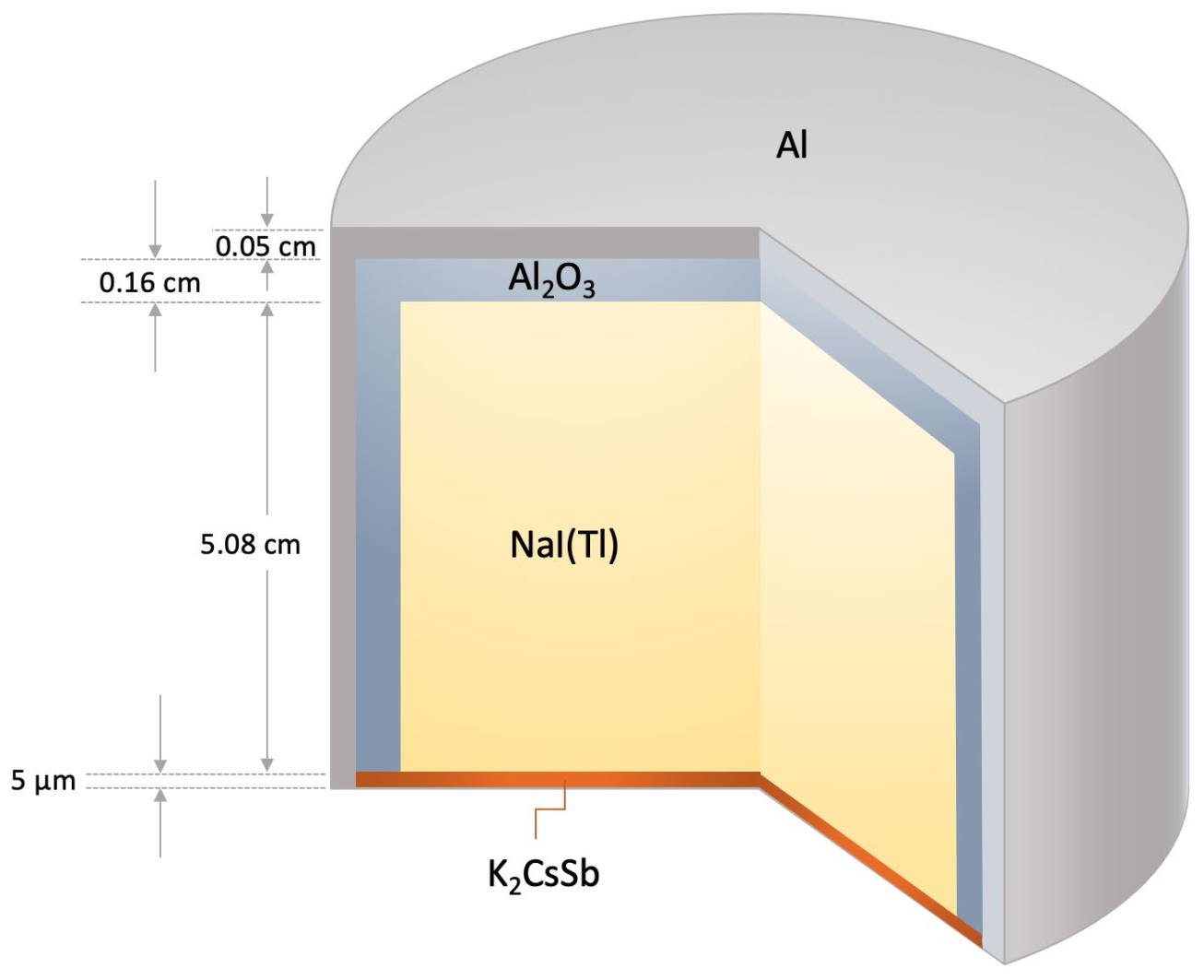
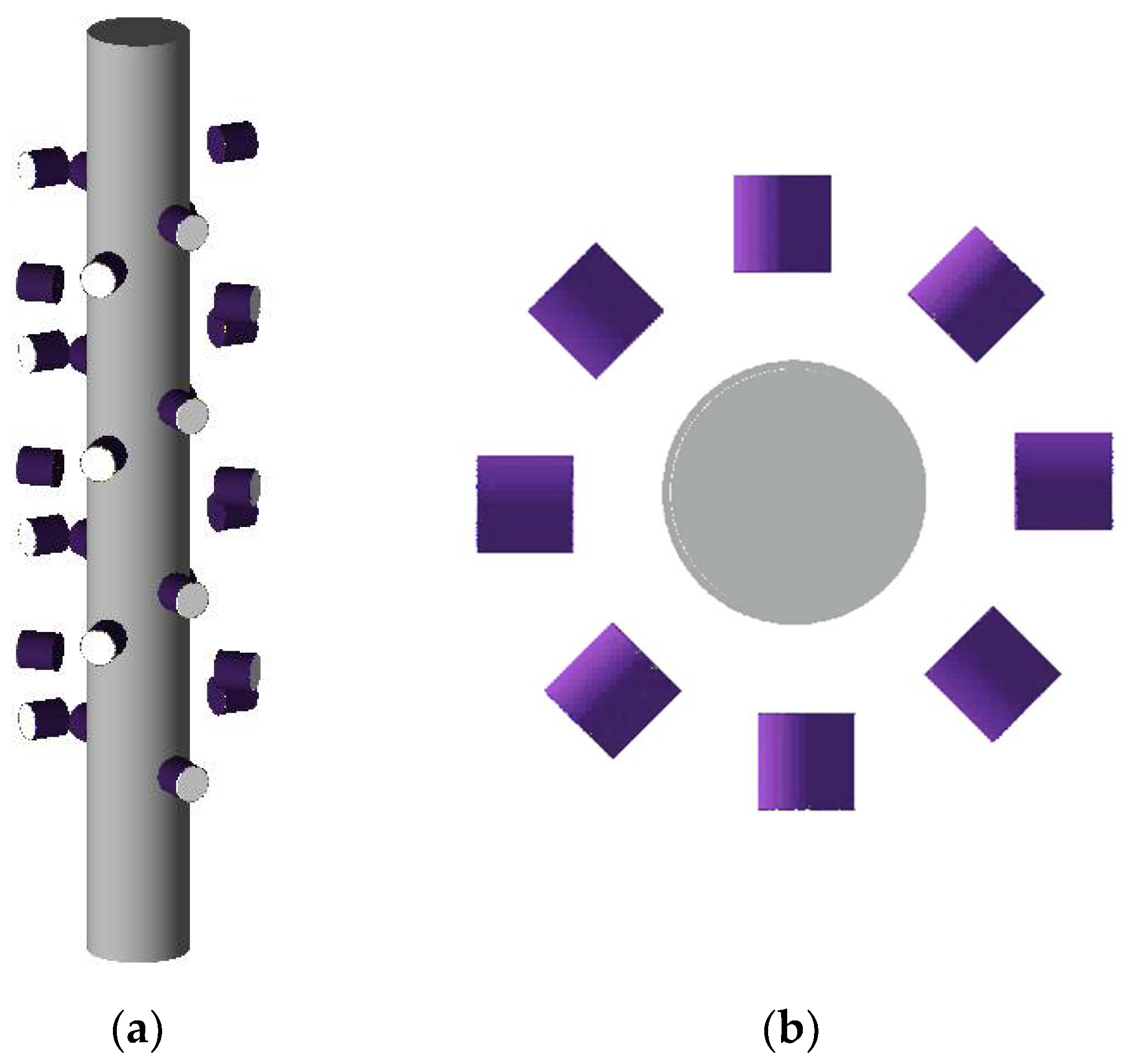
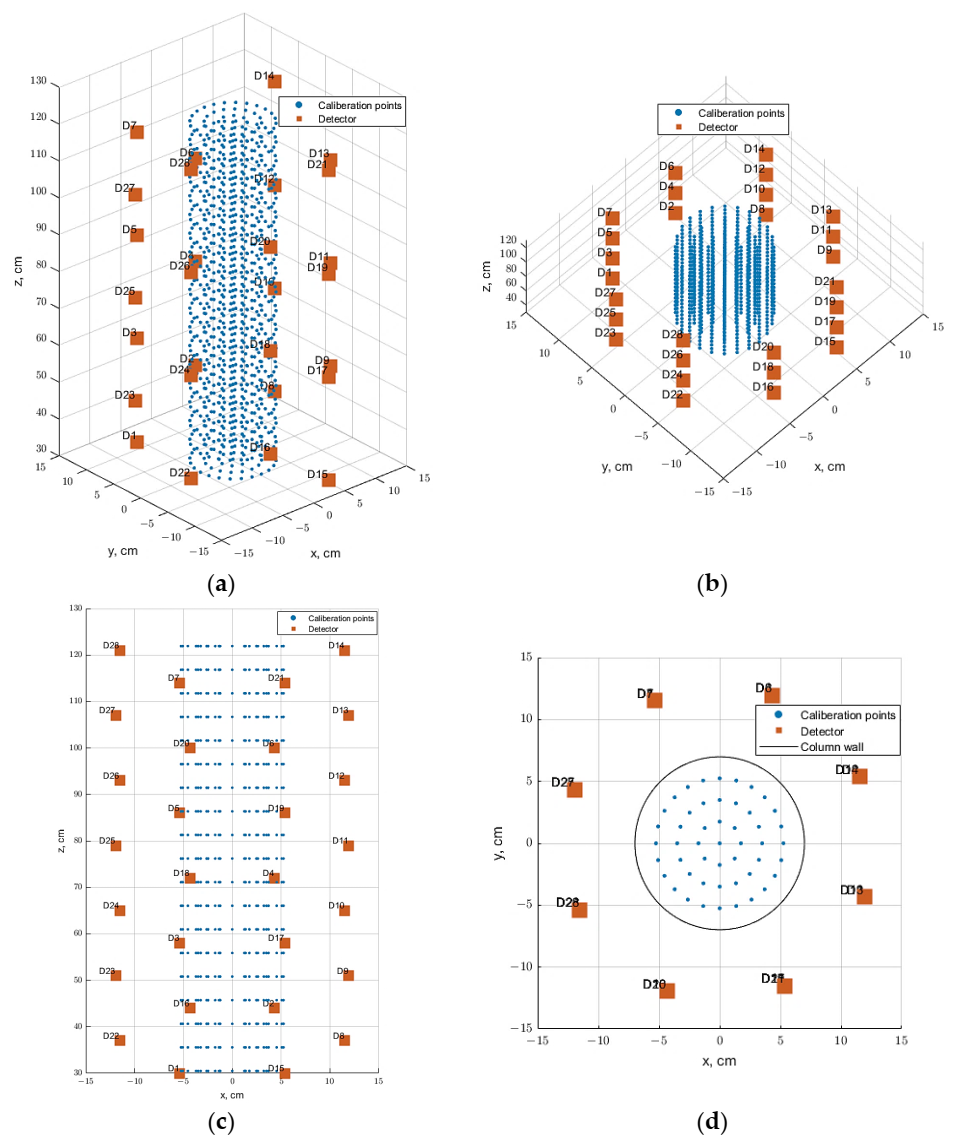

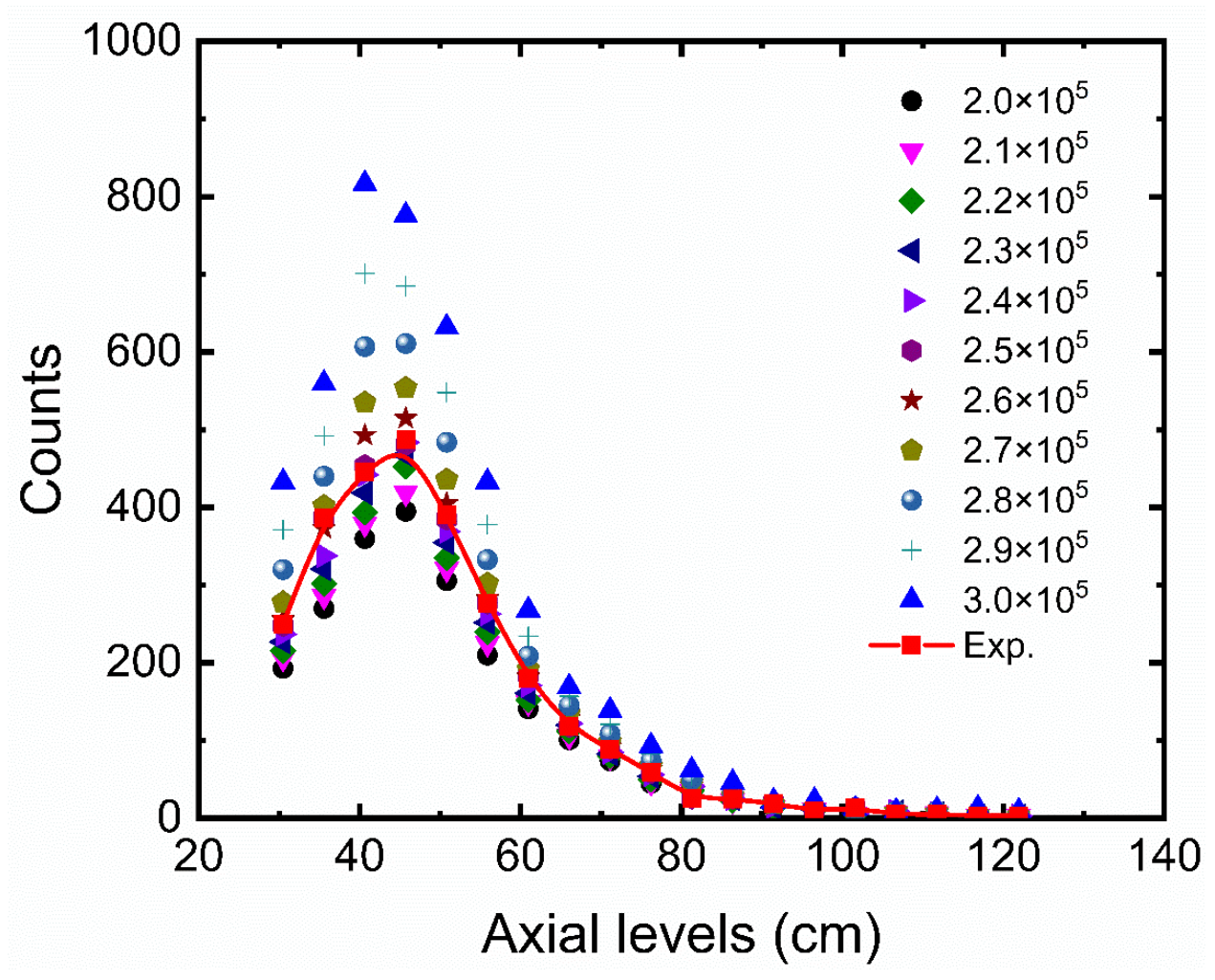
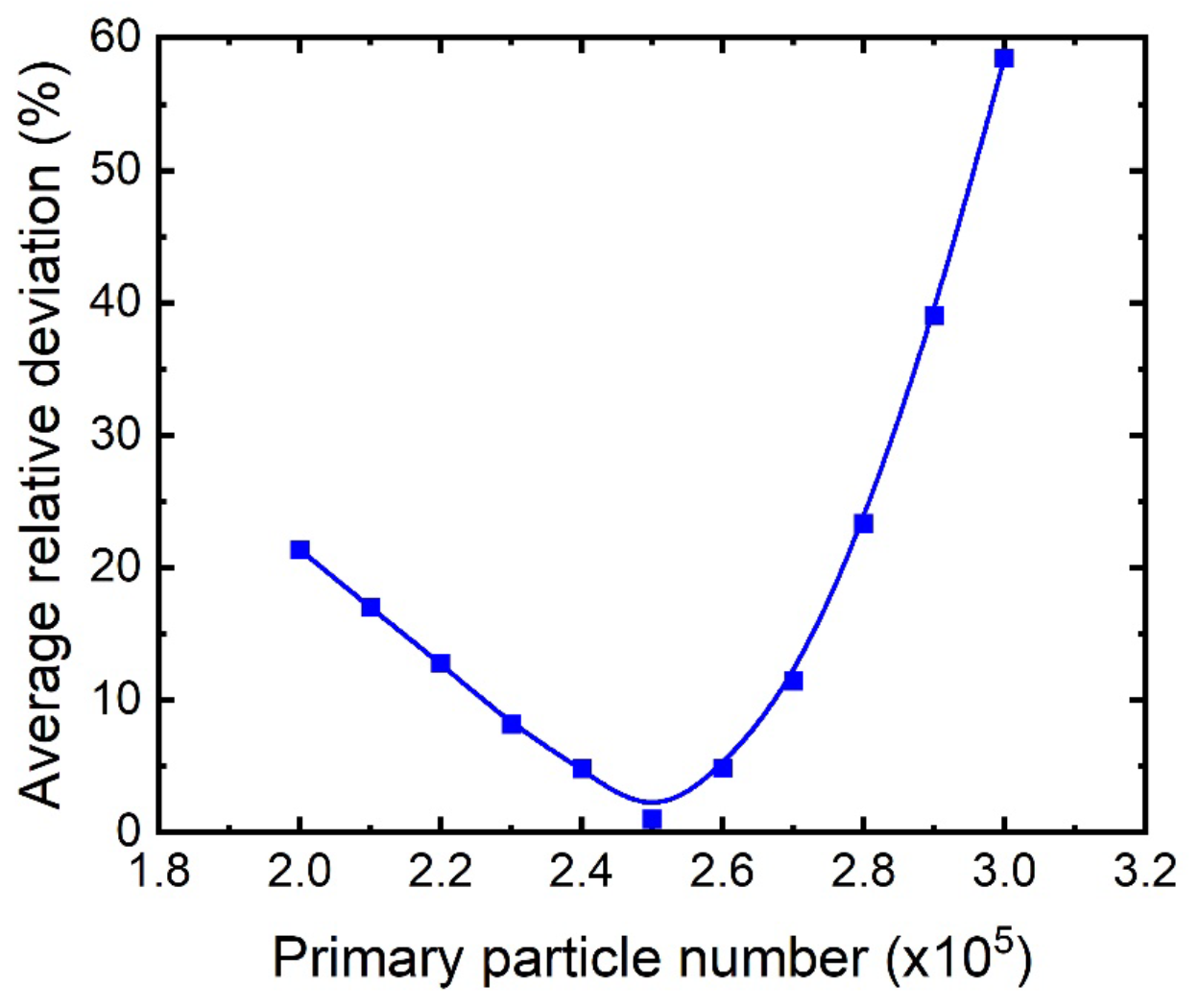

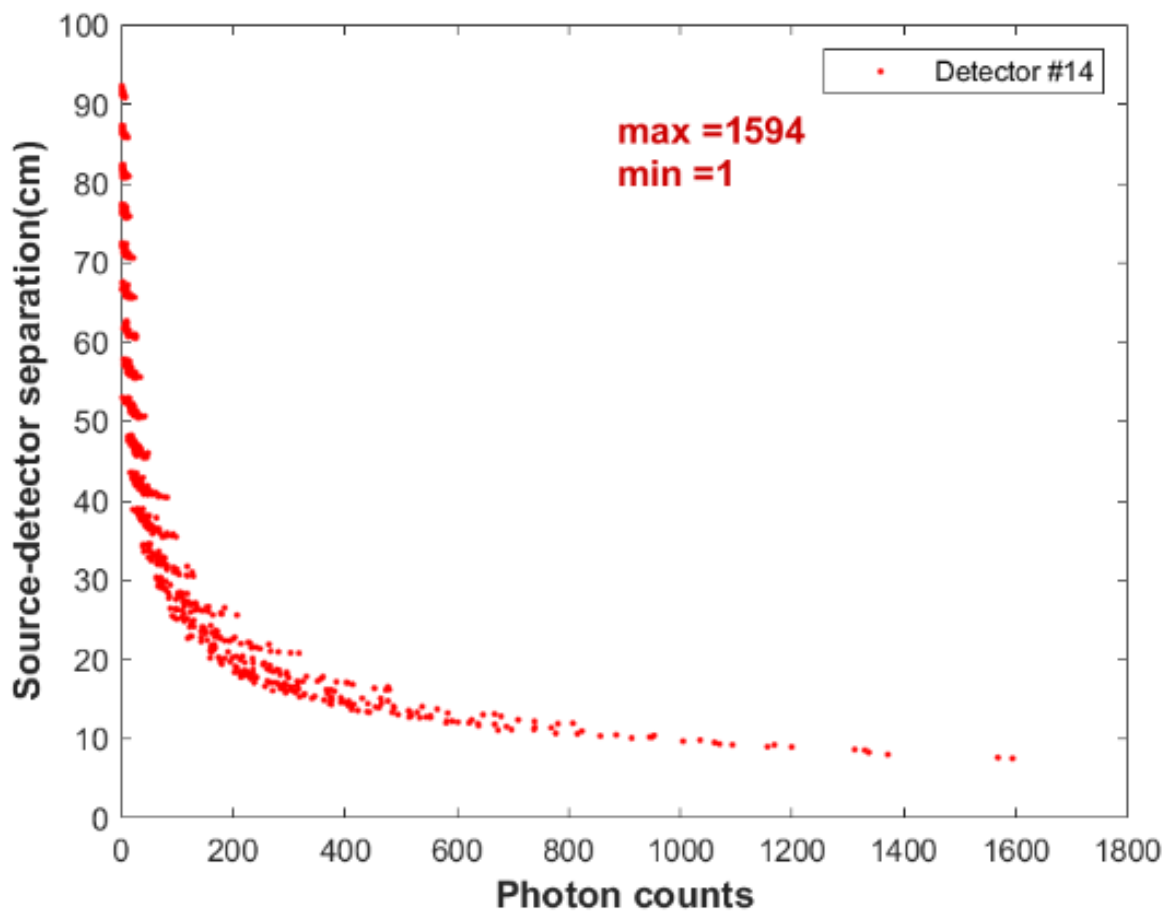
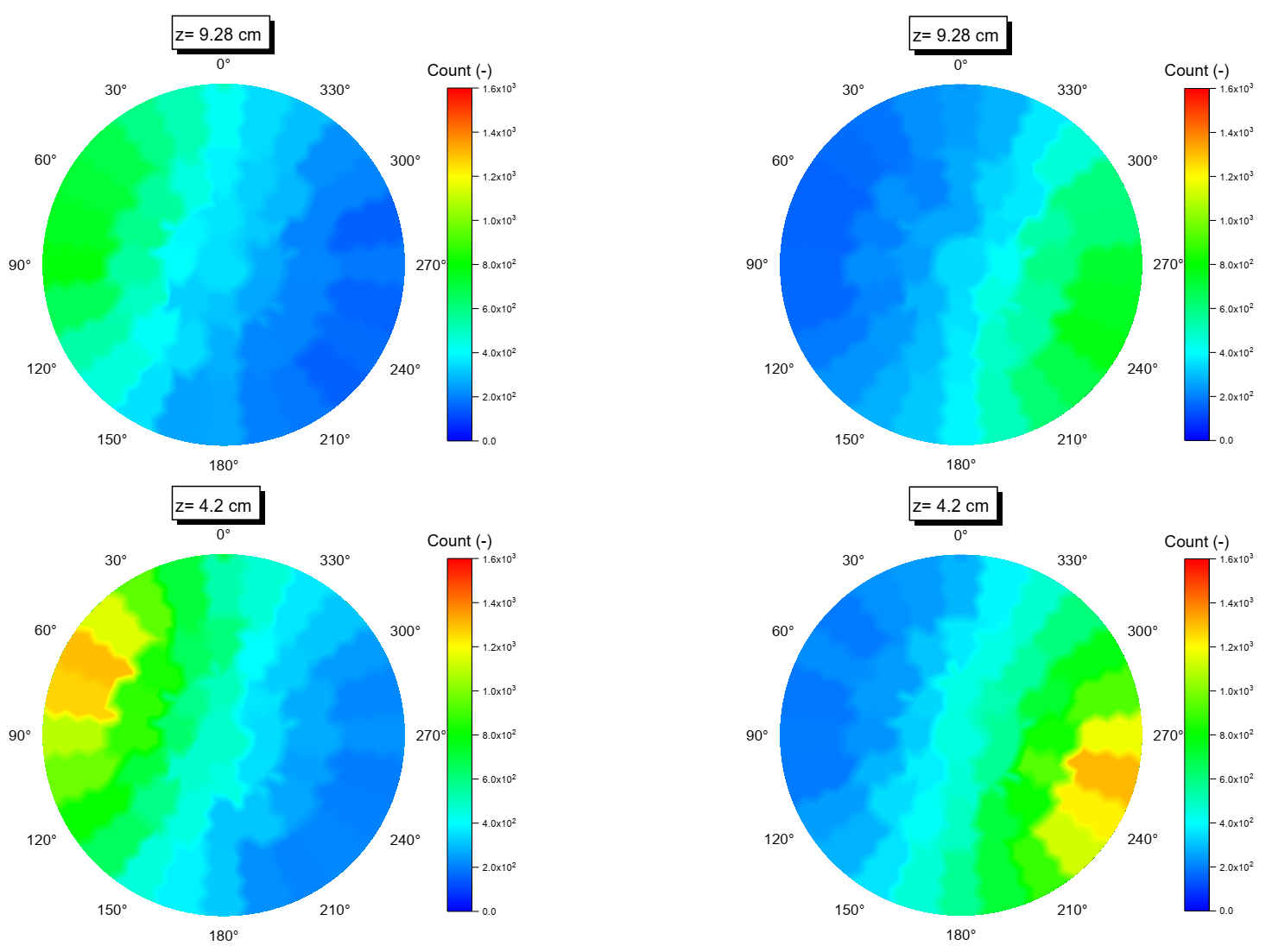

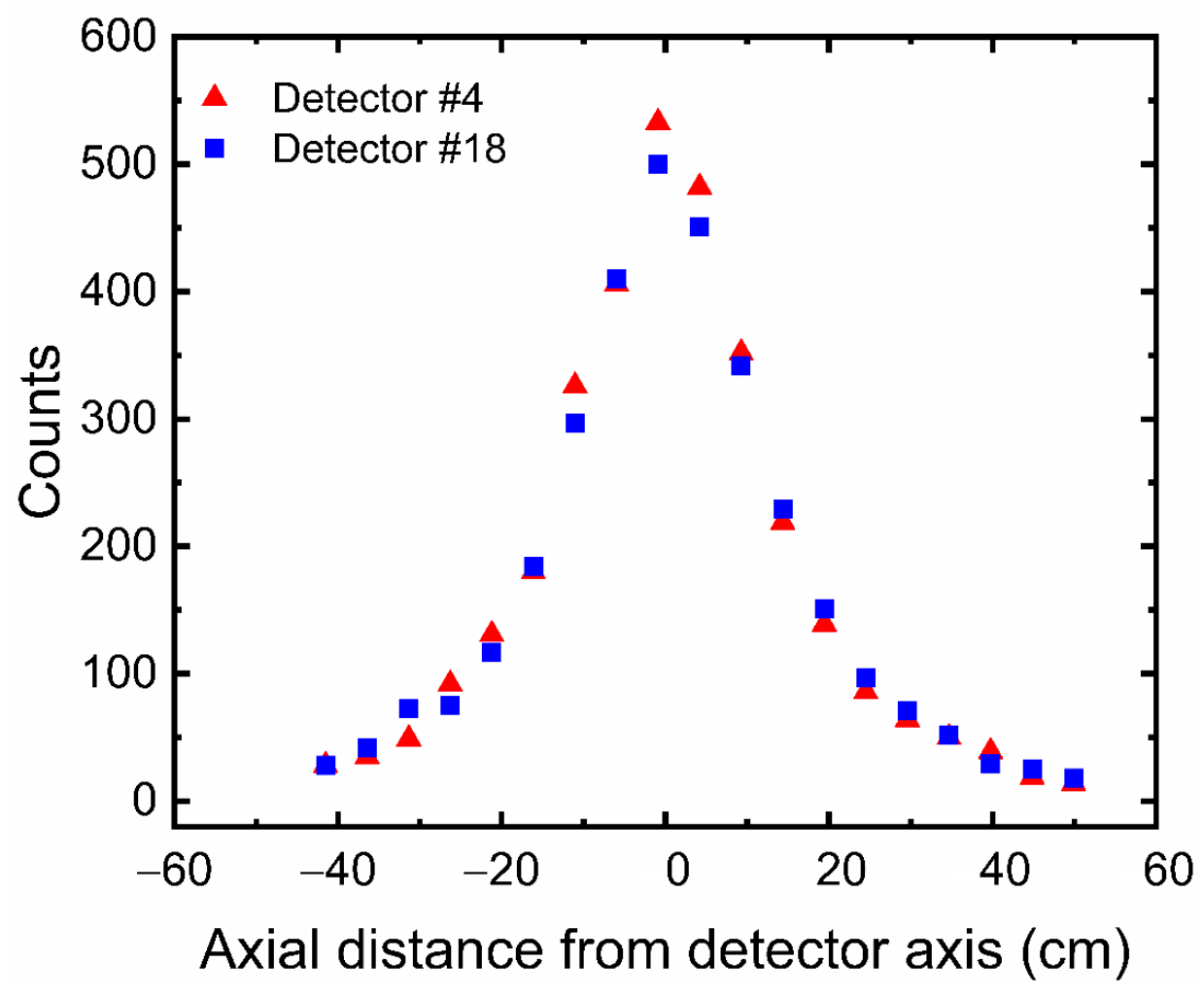

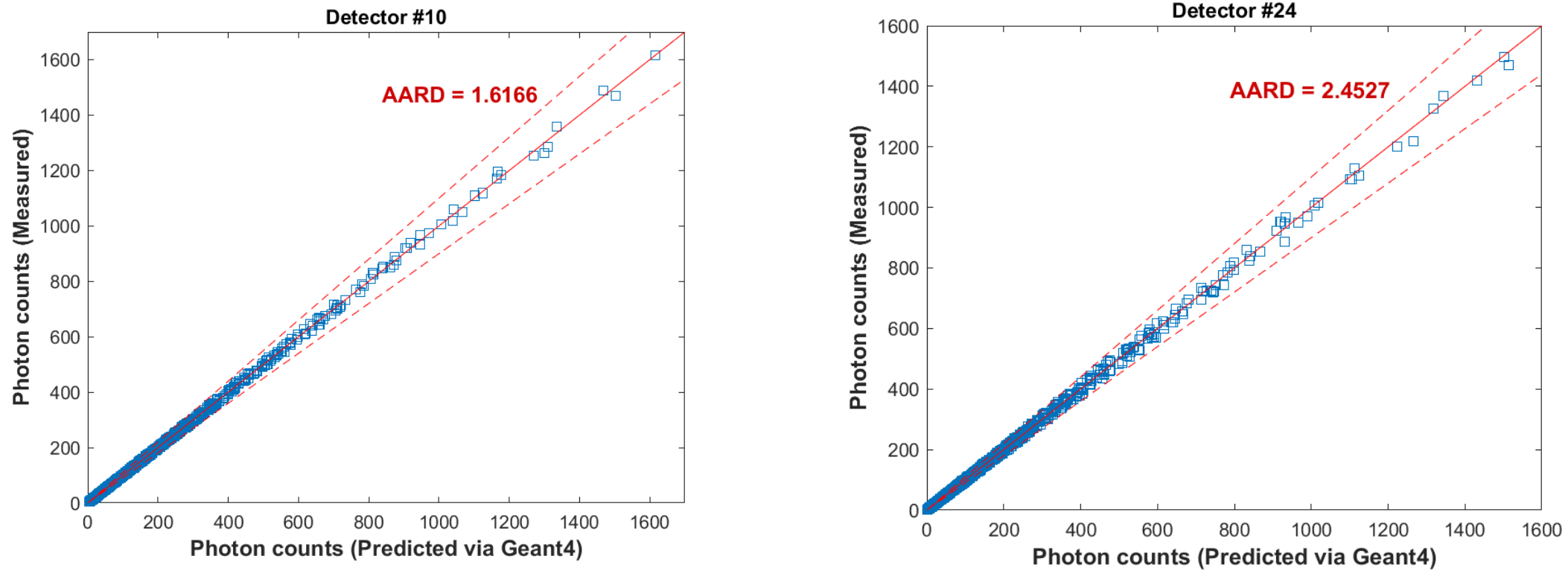
| Bar (#) | Detector (#) | r (cm) | θ (degree) | z (cm) | Bar (#) | Detector (#) | r (cm) | θ (degree) | z (cm) |
|---|---|---|---|---|---|---|---|---|---|
| 1 | 1 | 12.7 | 115 | 30 | 3 | 15 | 12.7 | 295 | 30 |
| 2 | 70 | 44 | 16 | 250 | 44 | ||||
| 3 | 115 | 58 | 17 | 295 | 58 | ||||
| 4 | 70 | 72 | 18 | 250 | 72 | ||||
| 5 | 115 | 86 | 19 | 295 | 86 | ||||
| 6 | 70 | 100 | 20 | 250 | 100 | ||||
| 7 | 115 | 114 | 21 | 295 | 114 | ||||
| 2 | 8 | 25 | 37 | 4 | 22 | 205 | 37 | ||
| 9 | 340 | 51 | 23 | 160 | 51 | ||||
| 10 | 25 | 65 | 24 | 205 | 65 | ||||
| 11 | 340 | 79 | 25 | 160 | 79 | ||||
| 12 | 25 | 93 | 26 | 205 | 93 | ||||
| 13 | 340 | 107 | 27 | 160 | 107 | ||||
| 14 | 25 | 121 | 28 | 205 | 121 |
Publisher’s Note: MDPI stays neutral with regard to jurisdictional claims in published maps and institutional affiliations. |
© 2022 by the authors. Licensee MDPI, Basel, Switzerland. This article is an open access article distributed under the terms and conditions of the Creative Commons Attribution (CC BY) license (https://creativecommons.org/licenses/by/4.0/).
Share and Cite
Alghamdi, A.A.; Aljuwaya, T.M.; Alomari, A.S.; Al-Dahhan, M.H. GEANT4 Simulation for Radioactive Particle Tracking (RPT) Technique. Sensors 2022, 22, 1223. https://doi.org/10.3390/s22031223
Alghamdi AA, Aljuwaya TM, Alomari AS, Al-Dahhan MH. GEANT4 Simulation for Radioactive Particle Tracking (RPT) Technique. Sensors. 2022; 22(3):1223. https://doi.org/10.3390/s22031223
Chicago/Turabian StyleAlghamdi, Ahmed A., Thaar M. Aljuwaya, Abdullah S. Alomari, and Muthanna H. Al-Dahhan. 2022. "GEANT4 Simulation for Radioactive Particle Tracking (RPT) Technique" Sensors 22, no. 3: 1223. https://doi.org/10.3390/s22031223
APA StyleAlghamdi, A. A., Aljuwaya, T. M., Alomari, A. S., & Al-Dahhan, M. H. (2022). GEANT4 Simulation for Radioactive Particle Tracking (RPT) Technique. Sensors, 22(3), 1223. https://doi.org/10.3390/s22031223







